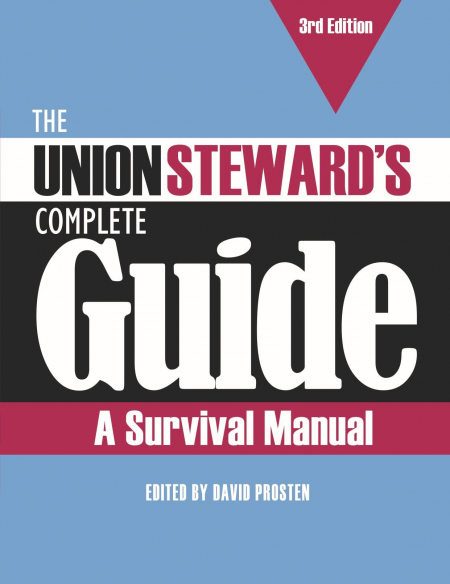Steward's Corner: Using Pressure to Settle Grievances

Reuters journalists lined up to make their management walk a "corridor of shame" on the way into a disciplinary meeting. Photo: News Guild of New York, cropped from original
What ultimately settles grievances? More often than not, it hinges on the union’s ability to pressure management to settle.
When managers look at the steward and the grievant across the table at a grievance meeting, they must clearly understand that they are dealing with more than just two people. They are dealing with the entire union. Management must also go to the grievance meeting feeling some immediacy, so they don’t drag the grievance out through all the steps.
The steward’s role is to orchestrate this pressure on management. It means that a steward must think and act like an organizer rather than getting caught up in the lawyer-client scene that so often surrounds the grievance procedure.
How the steward orchestrates pressure, and the amount of pressure needed, will differ from workplace to workplace. It will also differ with the seriousness of the grievance issue.
In determining the amount of pressure necessary to settle the grievance, the steward should brainstorm these questions with the grievant and other members:
- How serious is this kind of grievance?
Some incidents actually threaten worker well-being: safety and health violations, sexual harassment, discrimination, suspensions and firings. Others are more of the nuisance variety: failure to pay overtime, scheduling by seniority, minor forms of discipline. While every legitimate grievance requires the steward’s attention, often the less serious ones can be settled quickly through informal dealings with the supervisor.
- How widespread is this kind of grievance?
An incident that affects a number of workers will generate more pressure from the workers themselves. A pattern of isolated incidents against individuals may demonstrate that management is cracking down and establishing a pattern to undermine the contract.
- What has management’s response been toward this incident? The steward should expect that management will initially deny guilt. But if the denial is coupled with harshness or arrogance, you’ll want to crank up the pressure machine.

SUPPORT LABOR NOTES
BECOME A MONTHLY DONOR
Give $10 a month or more and get our "Fight the Boss, Build the Union" T-shirt.
Orchestrating pressure should be a fun and creative activity for the steward and co-workers. It opens up the grievance procedure and allows workers to direct their energy to solving the problem, not waiting for something to happen or someone to solve it for them.
Pressure activities can be designed so that workers begin with low-risk, minimum-time-commitment steps (signing a group petition) and build up so that they become comfortable with higher-risk, more time-consuming activities (job action).
Here are some examples:
SUBTLE PRESSURE
- Talking it up in the workplace. Workers discuss the case among themselves, within earshot of supervisors.
- Education. The general issue of the grievance—insubordination, sexual harassment, or whatever—is the subject for lunchtime or break meetings; flyers appear around the workplace announcing it.
- Publicity. Bulletin board notices (probably more faithfully read by supervisors than workers), flyers, articles in workplace newsletters appear about the issue involved in the grievance.
- Workers make sure the grievance is known about by the supervisor’s supervisor, other supervisors, and up the chain of command. This can be as simple as workers in different departments making casual comments all on the same day to their supervisors, such as, “The food service supervisor really treats his workers like dirt.”
- Workers from other departments sign the bottom of the grievance to show support.
DIRECT PRESSURE
- Workers—led by the steward—ask for a group meeting with management about the grievance issue. Even if the meeting is denied, the union makes the point that people know and are concerned.
- Workers wear a button, sticker, or armband to express their solidarity behind the union’s grievance.
- Workers sign a petition calling for swift and rightful resolution of the grievance and present it in a group to key management people.
- Workers alert the clients, customers, and/or the outside public about the grievance issue through informational leafleting, rallies, and use of the media.
Experienced stewards find that involving workers is a much more satisfying way of handling grievances. They also report that grievance wins are far more fulfilling than solving the problem alone with the individual grievant. And even grievance losses serve to unite workers more around blaming management—rather than the union steward—for the loss.
From The Union Steward’s Complete Guide: A Survival Manual, 3rd Edition. Edited by David Prosten. Available at labornotes.org/store. For bulk purchases, visit davidprostenbooks.com.





